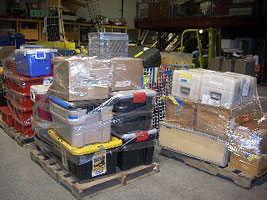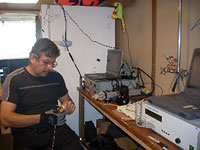

 | |||||||||||||||||||
|
|
Journals 2009/2010Jennifer Duncan
September 13, 2009 I tied up my waterproof hiking boots and am off to meet up with Dr. Jeremy Mathis. These boots are a lot different than my flip flops I usually wear in Florida. Dr. Mathis and the rest of the crew were in downtown Seward where the ship is docked. We are going to have to gather the gear and get the ship ready for the research trip. The only problem was it was pouring rain out, the power went out in the lodge and I couldn't seem to bring myself to leave this warm, dry, cozy room. However, the research must go on. We began loading the CTD rosette, multi-net, calvet and ring plankton nets, test tubes, zooplankton sample bottles, incubators, microscope, science freezer, and luggage. Yes, I was the one with the matching blue, largest luggage onboard. I had to take some teasing about that one. Nonetheless, the most important piece of equipment is the Conductivity-Temperature Depth (CTD) rosette instrument. We couldn't do without this instrument onboard; it was the heart of our operation. Rob Palomares from Scripps Oceanographic Institute was the CTD electronic technician who ran this machinery. He has had so much experience out at sea that he actually lived underwater for over 4.5 years (3 months at a time).
Our CTD rosette was equipped with 12 Niskin Bottles similar to large tubes, which close at specific depths starting at the deepest depth of that particular part of the seafloor. In the deeper regions the collection could start at 1000 meters deep, 500m, 200m, 150m, 100m, 50m, 40m, 30,m 20m,10m, and surface layer, respectively. These water collections are used for the scientists to chemically analyze its constituents. As the CTD travels down into the deep sea four sets of data are collected. Spontaneously, this data is sent to the computer including; Conductivity (similar to salinity), Temperature, Depth, and the Photosynthesis region. A detailed graph is formulated from this information and the thermocline and halocline can be determined. A thermocline is a region of rapidly changing temperature near the surface. The halocline is a region where salinity changes the most. These regions are significant to scientist for biological and chemical purposes. The conductivity sensor measures an induction in a parcel of water, which is dependent upon the salinity of the water. Temperature is measured with a thermistor and depth is inferred by a pressure measurement 1 decibar of pressure = 1 meter of depth. The Photosynthesizer Active Region or PAR measures the amount of electromagnetic radiation (visible light and UV waves) that transmit through the water. This is important to determine the depth at which photosynthesis can occur. One of the deepest regions was around 100m. This means that phytoplankton may be able to grow up to 100 meters deep. Phytoplankton are extremely important. They produce 80% of our Oxygen we breathe here on Earth and they are also at the very bottom of the food chain. They are considered to be the primary producers of the sea. High levels of phytoplankton can cascade up the food chain and possibly support high stocks of salmon and other commercially important fish. |
||||||||||||||||||



